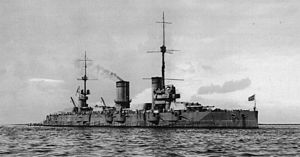Gangut-class battleship

Gangut during World War I
|
|
| Class overview | |
|---|---|
| Builders: | |
| Operators: | |
| Preceded by: | Andrei Pervozvanny class |
| Succeeded by: | Imperatritsa Mariya class |
| Built: | 1909–14 |
| In commission: | 1914–56 |
| Planned: | 4 |
| Completed: | 4 |
| Lost: | 1 |
| Scrapped: | 3 |
| General characteristics | |
| Type: | Dreadnought |
| Displacement: | 24,800 metric tons (24,400 long tons; 27,300 short tons) |
| Length: | 181.2 m (594 ft 6 in) |
| Beam: | 26.9 m (88 ft 3 in) |
| Draft: | 8.99 m (29 ft 6 in) |
| Installed power: | 52,000 shp (39,000 kW) (on trials) |
| Propulsion: |
|
| Speed: | 24.1 kn (44.6 km/h; 27.7 mph) (on trials) |
| Range: | 3,200 nmi (5,900 km; 3,700 mi) at 10 kn (19 km/h; 12 mph) |
| Complement: | 1,149 |
| Armament: |
|
| Armor: |
|
The Gangut-class battleships, also known as the "Sevastopol class", were the first dreadnoughts begun for the Imperial Russian Navy before World War I. They had a convoluted design history involving several British companies, evolving requirements, an international design competition, and foreign protests. Four ships were ordered in 1909; two were named after victorious battles of Peter the Great in the Great Northern War and the other two were named after battles in the Crimean War. Three ships of the class used names of pre-dreadnought battleships of the Petropavlovsk-class lost in the Russo-Japanese War. Construction was delayed by financing problems until the Duma formally authorized the ships in 1911. They were delivered from December 1914 through January 1915, although they still needed work on the turrets and fire-control systems until mid-1915. Their role was to defend the mouth of the Gulf of Finland against the Germans, who never tried to enter, so the ships spent their time training and providing cover for minelaying operations. Their crews participated in the general mutiny of the Baltic Fleet after the February Revolution in 1917, and joined the Bolsheviks the following year. The Russians were forced to evacuate their naval base at Helsinki after Finland became independent in December 1917. The Gangut-class ships led the first contingent of ships to Kronstadt even though the Gulf of Finland was still frozen.
...
Wikipedia
